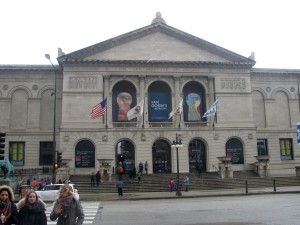
A small sample of Korean culture in Chicago. The fame of old Korean pottery has spread around the globe. We’ve seen a wonderful history of Korean pottery in the National Museum of Korea in Seoul, but here it is in Chicago too, at the Art Institute, one of the world’s top Art Museums.
We visited the Art Institute in Chicago (mainly to see the special exhibition on Van Gogh’s Bedrooms) on our way to Korea last April. So, we decided to also look at the Art Institute’s special small exhibit on Korean Goryeo Pottery/Celadon.
It was a small exhibit, but each piece is perfect, mostly the delicate green color, very shiny and exquisitely crafted. It’s wonderful to see masterpieces from so long ago, each one a true work of art.
There were many ewers, some with floral or bamboo themes, illustrating the importance that bamboo has played in Korean culture for so long (I recently wrote about a Korean Bamboo Park, see here https://vivskoreanadventures.wordpress.com/2016/04/06/damyang-bamboo-park-juknok-won/ ).
Korean pottery seems to be distinguished from other Asian pottery in that it’s green,
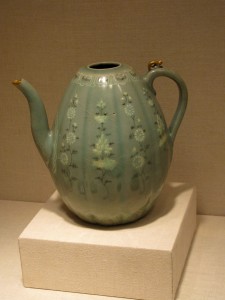
with an elegant classical style. The pieces were all made to be used by wealthy people—oil lamps, water jugs etc—to be used in the home or Temple.
Korea is very famous for pottery, so here’s a bit of background.
Quick History
(Summary taken from the information boards in the Art Institute)
Over the last 2,000 years, Korean potters have created ceramics of amazingly diverse form and technique. Probably the most distinctive are celadon-glazed stonewares that were commissioned for use by the imperial court, aristocracy, and large Buddhist monasteries during the peaceful and prosperous Goryeo dynasty (918-1392).
Initially emulating celadon imported from China, Korean potters created a soft green-glazed ware by firing iron-rich clay coated with an iron-oxide glaze in a reduction (low oxygen) kiln. By the 12th century, they had created surfaces of previously unseen luminosity by adding porcelain stone to the glaze mixture. These Korean celadons display a radiant bluish green “kingfish er” glaze. This was either left pure or enhanced with decorative motifs that were gracefully carved or pressed into a mold. Designs painted in underglaze iron oxide created bolder effects.
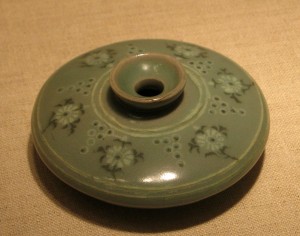
The Goryeo potter’s most innovative contribution to the celadon tradition was inlaid decoration (sanggam). They created this by cutting designs into the unbaked clay and filling the grooves with creamy white and brown or reddish brown inlays. The white was primarily crushed quartz, and the darker color was melted and crushed glaze materials. The surface was then scraped smooth of excess inlay and the vessel glazed and fired. Inlaid designs include pictorial scenes, dynamically twisting dragons, and, very commonly, small, symmetrically placed chrysanthemum blossoms.
Most Goryeo celadons were elegant and functional vessels—wine ewers inspired by melons or bamboo, petal-lobed cups, and stands for wine or tea, small cosmetic basins, and flattened bottles possibly used for hair oils. The potter, however, also made intricately constructed and exuberantly fanciful pieces, such as the bird-shaped ewer (No 1 below).
No 1: Bird-shaped ewer with crowned rider holding a bowl. Goryeo dynasty, 12th century. In this whimsical ewer, an official with a formed head-dress rides astride a plump, crested waterbird. The birds’ wings are extended as if in flight and its tail swoops up to form the handle. Liquids could be poured into the round vessel held by the rider and out through the bird’s smiling beak.
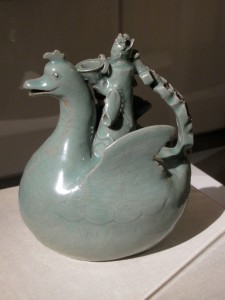
Vase (Maebyong) with stylized floral sprays. Celadon-glazed stoneware with underglaze painting, 12th century (pic below).
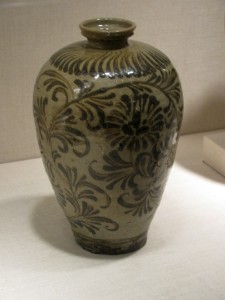
Lobed vase with stylized floral scrolls. Celadon-glazed stoneware with underglaze painted decoration, 12th century (pic below).
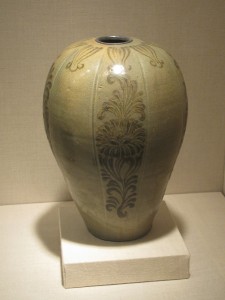
Bottle with bamboo fluting. Celadon-glazed stoneware with underglaze carved and incised decoration, 13th century.
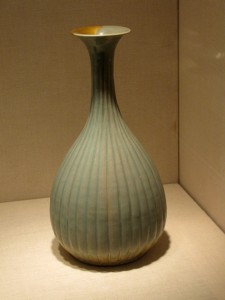
Gourd-shaped ewer with twisted rope handle, lotus leaves and floral sprays. Celadon-glazed stoneware and underglaze carved decoration, 12th century.
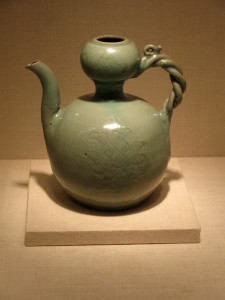
Ewer formed as a sprouting bamboo. Celadon-glazed stoneware with underglaze carved and incised decoration, 12th century.
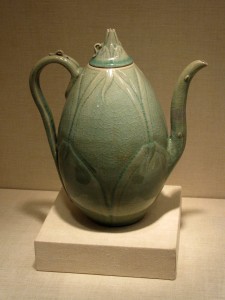
Lobed cup and stand with chrysanthemum flower heads. Celadon-glazed stoneware with underglaze carved and incised decoration, 12th/13th century.
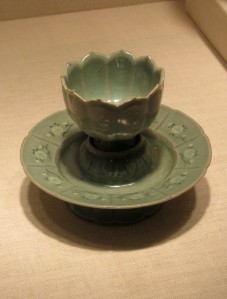
All delicately gorgeous! Master craftsmen so long ago.
